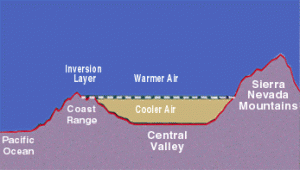AB 296 could make Gov. Brown a global warming ‘denier’
By Wayne Lusvardi
A piece of legislation may end up putting Gov. Jerry Brown on the global warming “denier” hot seat. It’s AB 296, the Cool Pavements Research and Implementation Act, sponsored by Assembly Member Nancy Skinner, D-Berkeley. That is because if Brown signs the bill into law he will have to “deny” accepted global warming science about how inversion layers create smog.
Skinner’s bill would develop definitions, draw up new building codes and allocate $2 million for research and pilot projects to use cooler paving materials on freeways and highways to reduce “global warming” and the local “urban heat island effect.” An “urban heat island effect” is created when soil and vegetation is replaced with impervious paved roads, sidewalks and buildings.
But the proverbial “rubber meets the road” when it comes to the lack of a scientific basis for legally adopting cool road pavement standards.
Cool Pavement Would Be Health Disaster, Says Professor
Mark Jacobson, professor in the department of Civil and Environmental Engineering at Stanford University, says switching to cooler — and thus lighter colored — road-paving materials to reduce global warming would be a “public health disaster waiting to happen.” He said it is very well known in environmental science that “pollutants would hug the ground surface” if hardened road surfaces were cooler.
According to Jacobson, cooler and lighter-colored road pavement would cause colder and thus more stationary air near the ground surface. In turn, this would reduce cloudiness and allow more sunlight to reach the ground surface. Jacobson used the analogy of hot air rising in a room. He said it would be very difficult to push air upward if it were cooler than hot air above.
Cooler ground surface air would result in the creation of an “inversion layer” that traps pollutants in what we call smog. To prevent smog, heat and moisture must be allowed to rise to form clouds.
Jacobson further said that any lighter-colored road surface would probably only last a few days until particulate matter from diesel-fueled vehicles and soot from rubber tires darkened the road surface.
Another problem raised by Jacobson was that cooler road paving would only theoretically work better in the summer. But the extra heating costs in the winter would outweigh those theoretical summer benefits, according to a study done at the National Center for Atmospheric Research.
Jacobson is an atmospheric scientist. His research indicates the urban heat island effect is a relatively minor contributor to warming compared to greenhouse gases and particulate black carbon. Jacobson’s research showed that white roofs caused greater net global warming because they resulted in creating an inversion layer.
But Skinner’s cool pavements bill continues to roll toward adoption regardless of a lack of any sound basis in global warming science or health science.
Cool Pavements Bill Steamrolled Through Legislature
AB 296 would require the California Environmental Protection Agency first to define the term “Urban Heat Island Effect” and develop a standard specification for “sustainable or cool pavements.”
Upon the completion of the definition of “urban heat island effect,” Caltrans would be required to develop a standard specification for cool pavements for freeway and highway construction to reduce the “urban heat island effect.”
AB 296 was first introduced in the Assembly on Feb. 9, 2011. It was approved in the Assembly on June 1, 2011 along straight Democratic Party lines, 54 to 21 and advanced to the Senate. It was passed by the State Senate on Aug. 29, 2012 and now goes to the governor for signature.
Will Brown Join the “Denier” Club?
AB 296 will now be forwarded to California’s most environmentally activist governor for signature. This is ironic because AB 296 has no known basis in accepted atmospheric science and would result in greater warming and air pollution. The resulting greater air pollution would be hard to deny as an unanticipated consequence because it is certainly foreseeable.
Repeatedly, Brown has declared that science is on his side in the contentious debate over global warming. Recently, he has called global warming skeptics “deniers” of accepted science. But accepted atmospheric science about how inversion layers create urban air pollution does not support the Democratic Party’s legislation for cool pavements. In fact, cooler road pavement will result in the reverse effect — greater global and local warming.
Brown has painted himself into a corner of a hot paved road with a diesel truck headed in his direction with his “denier” rhetoric about global warming skeptics. If Brown approves AB 296, he will join the ranks of those “global warming deniers.”
Related Articles
Do they really want to combat global warming?
Commentary Oct. 31, 2012 By John Seiler Nowadays, almost anything that happens is blamed on “global warming.” Or its more
Drill here, drill now
Feb. 3, 2010 Drilling for oil off of California’s legendary coastline is a topic that polarizes the critics of offshore
An open letter to bullet-train board Chairman Dan Richard
Dan Richard was at it again in Saturday’s Los Angeles Times. LAT’s Ralph Vartabedian did a good job painting a downbeat




